 This Shtetlinks page was
created by Phyllis Kramer. Updated January 2019. Copyright © 2000.
Since August 2001, you are visitor#:
This Shtetlinks page was
created by Phyllis Kramer. Updated January 2019. Copyright © 2000.
Since August 2001, you are visitor#: 
Up until 2019, Phyllis Kramer (OBM) developed and maintained this
KahilaLink. Phyllis did a wonderful job documenting and sharing
information about this shtetl. Starting in July 2021 Jeff Alexander
is trying to fill Phyllis’s shoes.
Please contact Jeff Alexander regarding
any questions that you might have.
From our researcher, April 1998: " On July 7, 1942 the Jews
of Zmigród and surrounding villages were taken to the mountain
Halbów, where they were shot dead by the Nazis. 1250 men, women and
children were massacred. With them Zmigród died. 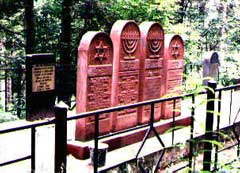
The Halbów Monument Stands on the mass grave
of 1250 Jews who were murdered by the Nazi-barbarians on July 7,
1942.
In loving memory
Here rest 1250 Jewish men, women and children of Zmigród and
neighboring towns, murdered by the Germans on July 7, 1942 !
Never to be Forgotten
Erected by Zmigród Society in New York 1990
Pure of heart and consecrated they suffered a harsh death
Take my revenge from those who tormented me
. . . .
by Max Findling and Leo Rosner
In 199l, forty six years after the Holocaust,I Leo Rosner, Max
Findling and Shimshon Findling returned to Zmigrod Nowy Poland.
We were acccmpanied by Max's son Michael Findling and Shimshon's
daughter Regine Findling. The purpose of the trip was to search
and find the locations of the burial graves of our beloved
families who were shot and killed by the Nazis in the year 1942.
As a result of our childhood memories of 1942, we were able to
locate the mass grave, which was in the village of Halbuv. The
grave is located about seven kilometers from the town Zmigrod on
the way to the Czechoslovakian border about thirty kilometers
ahead. At this site in July of 1942 the Gestapo massacred twelve
hundred and fifty people, men, women and children, these victims
were all buried in this mass grave.
In 1993 we returned to this mass grave and in memory of these
innoncent victims we erected four  monuments. These monuments have inscribed the
date and the year of the execution in three languages: Hebrew,
Polish and English. This mass grave is covered with a cement
block measuring 30 feet long by 12 feet wide. There is a metal
fence surrounding this entire site. In addition there is a road
sign about two hundred and fifty meters from the gravesite. This
sign informs visitors of the mass grave located within the
forest ahead. The monuments and sign were erected with donations
from surviving members as well as their families and friends.
monuments. These monuments have inscribed the
date and the year of the execution in three languages: Hebrew,
Polish and English. This mass grave is covered with a cement
block measuring 30 feet long by 12 feet wide. There is a metal
fence surrounding this entire site. In addition there is a road
sign about two hundred and fifty meters from the gravesite. This
sign informs visitors of the mass grave located within the
forest ahead. The monuments and sign were erected with donations
from surviving members as well as their families and friends.
Max Findling and I, after leaving Zmigrod, visited the Jaslo
prison where we both were incarcerated in the year of 1942. At
the same time with us were Max's sister (Geitel Findling), my
mother (Esther Rosner),and my younger sister (Malka Rosner).
Among the other Jewish prisoners, men women and children,
included two famous Rabbi's (Rabbi Chuno Halberstarm from
Kolicice and Rabbi Meilech Rubin from Jaslo. There were 35 men
in one cell; the women were in a seperate cell.
One day Max and I were chosen by the Gestapo for work, along
with 14 other young men. The rest of the prisoners were taken
about one week later to the forest Warzyce, located outside the
town of Jaslo; they were then shot and killed and buried in an
unmarked grave. Days later, as Max and I continued to work,
cleaning out Jewish homes of clothing, furniture, and other
items, we entered a warehouse and found the clothes of my
mother, my sister and Max's sister. It was the clothes they wore
while in prison. This was the evidence for us to know for sure
the outcome of our loved ones.
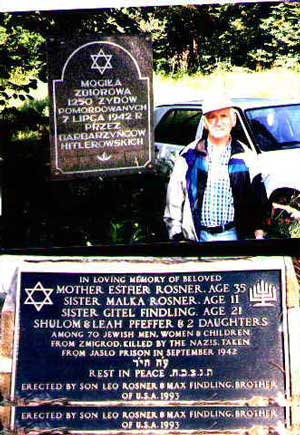 This forest Warzyce
includes thirty two mass graves where over five thousand people
were executed. On the unmarked grave of our loved ones we placed
a bronze plaque, brought from the United States, prepared with
the names of those buried.
This forest Warzyce
includes thirty two mass graves where over five thousand people
were executed. On the unmarked grave of our loved ones we placed
a bronze plaque, brought from the United States, prepared with
the names of those buried.
The photographs at right were taken in 1999; they show Max
Findling beside the roadside sign (top photo) and the plaque at
Warzyce (below).
signed, Leo Rosner and Max Findling, May 2001
. . . .
The Monument in Zmigród is really a collection of monuments.
And the following tells of the many steps that were taken.
- Pinchas Walmut returned to Zmigród after the war and
organized about 50 Zmigródians from Israel, Europe and the US;
he created the permanent concrete base and gates and a
monument in 1950 for the mass grave.
- In 1991, members of the New York Zmigród Society returned.
This group included Max Findling and his son Michael Findling,
Simon Findling, Leo Rosen and his daughter, Naftuli Lax and
his two sons, and Zelig Eisenberg. They found that the stone
monument was weathered and unreadable; back in the US they
arranged for a replacement. Mrs. Helen Findling designed 5 of
the stones based on the 10 commandments, and Max Findling
negotiated the construction and secured the necessary permits
from the governments in Yaslo and Krosno to erect the
replacement stones.
- In 1993 at a ceremony at Halbow, the group was present at
the erection of the new monument. It was a sad but gratifying
moment. Now those friends and family who were killed and
buried at Halbow, would be remembered and honored.
In July 98 our researcher was able to read the inscriptions of
the gravestones on the Halbow monument. There are ten stones,
excluding the 4 memorial stones (decalogue), designed by Helen
Findling. From the left to the right:
- (inscription washed off)
- Ester ROZENHAND murdered on July 7, 1942 in Halbow
- KRILL: Maier Jozef Icek Mozes Aron Neoha Mirim Errenreich,
Estera
- (horizontal, laying stone) JUST
- (stone behind decalogue) In memory of our father Dawid
WYMYSLNER and family members erected by his sons and daughters
- BEER WALTER RUBENFELD
- WOHLMUT, Brandla and her children Jakob Wiktor Leib Hirsz
Menek Reizla Estera Laja
- LERMAN Chaim Mariem Sita
- Aron HALBERSTAM Rubin EIZENBERG
- GELDZÄHLER Helena, mother, 48. Maria, daughter,21,Genia,
daughter,16,Salomeo, daughter,16,Marcin, son, 14.
. . . .
And then in 2004 a dreadful thing happened
The monuments succombed to erosion, they tumbled over, cracked and
lay broken on the ground. It was through this web page, that a
Polish lady saw the momuments cracked and broken, and emailed me
through her brother who was residing in the States. I sent the
notes to Max Findling. 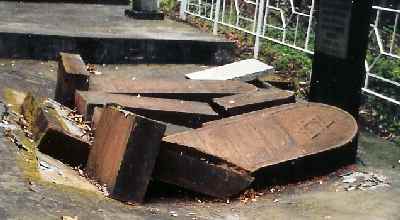
Max Findling, who was born in Zmigrod, and was part of
the original group which erected the monuments, was very
concerned. He wrote three letters (in Polish) to three different
agencies in Poland: to the Government in Warsaw, to the Governor
of Rzeszow and to the town of Krempna. He sent the photos of the
monuments before and after the erosion and asked for help to
restore the monuments.
Weeks later Max received a letter from the office of the
Governor of Rzeszow, that the government in Warsaw was
allocating 20,000 zloties to restore the monument and that it
would be done over the summer of 2005.
Max asked a Polish engineer to inspect the results; soon we
received the photograph you see below. We are proud to present
this photograph (October 2005) showing the results of the Polish
Governments' labors (they even painted the gate and the
gravestones):
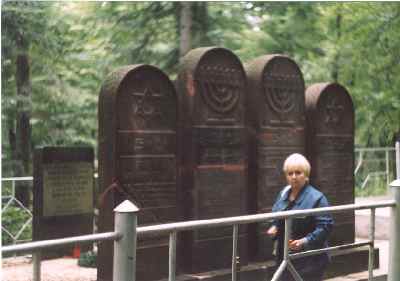 and for this we are very grateful. Thankyou.
and for this we are very grateful. Thankyou.
. . . .
The Siegfrieds
The following was written by Lillian Siegfried of Staten
Island, NY:
David Siegfried who survived in Siberia, USSR, was involved in
the post-war  establishment of the monuments in Halbow, Poland, when he
returned to Jaslo. Among the victims of the Nazi massacre was
his aunt Malka Siegfried-Lerman, her husband and her children
from Oscik. The only member to survive was Moisha Lerman.
establishment of the monuments in Halbow, Poland, when he
returned to Jaslo. Among the victims of the Nazi massacre was
his aunt Malka Siegfried-Lerman, her husband and her children
from Oscik. The only member to survive was Moisha Lerman.
Return to Table of Contents
. . . .
This is a collection of over 120,000 victims persecuted under
the Nazis in Germany 1933 to 1945. It includes all those who were
categorized as Jews by the Nazis, regardless of whether they were
halachically Jewish or thought of themselves as Jews. Search using
Familienname (surname) together with Geburtsdatum range (birth
date range from to). If you select a person you will find their
birth place and where they lived prior to deportation together
with the date and place of their death. Although the list has
mostly German Jews, it works well searching for your surnames, as
it presents the place of birth in the results. The list that
follows was sourced by querying the shtetl name from:
http://www.bundesarchiv.de/gedenkbuch/directory.html. The list
includes maiden names.
- Akselrad, Mathilde Matylda, née Berger,born on 28th July 1907
in Nowy Zmigrod / Jaslo / Galizien,resident of Würzburg.
Emigration:30th June 1939, Belgien. Deportation: from Mechelen
(Malines) 08th September 1942, Auschwitz, Konzentrations-and
extermination camp
- Aumann, Selig Siegmund, born on 10th March 1883 in Nowy
Zmigrod / Jaslo / Galizien, resident of Dortmund. Expulsion:
28th October 1938 to Bentschen (Zbaszyn). Imprisonment: until
summer 1939, Bentschen (Zbaszyn), internment camp
- Beck, Reisel Beisel, born on 15th May 1898 in Nowy Zmigrod /
Jaslo / Galizien ,resident of Frankfurt a. Main. Deportation:
from Frankfurt am Main 11th/12th November 1941, Minsk, ghetto
- Berger, Heinrich born on 08th August 1907 in Nowy Zmigrod /
Jaslo / Galizien resident of Nürnberg
- Berger, Jenta Jeanette née Gärtner born on 22nd October 1889
in Nowy Zmigrod / Jaslo / Galizien resident of München.
Emigration: 07th August 1939, Poland
- Birnbach, Regina, née Birnbach, born on 10th August 1901 in
Nowy Zmigrod / Jaslo / Galizien, resident of Dortmund,
Expulsion: 28th October 1938 to Bentschen (Zbaszyn).
Deportation: unknown place of deportation; Destiny: officially
declared dead
- Birnbach, Szulim Salomon born on 15th January 1897 in Nowy
Zmigrod / Jaslo / Galizien,resident of Unna.Expulsion:28th
October 1938 to Bentschen (Zbaszyn).Imprisonment:until summer
1939, Bentschen (Zbaszyn), internment camp. Deportation: Lublin
- Blechner, Basia Basie born on 10th August 1908 in Nowy Zmigrod
/ Jaslo / Galizien resident of Chemnitz, Expulsion: 28th October
1938 to Poland
- Blechner, Lea née Findling, born on 18th January 1874 in Nowy
Zmigrod / Jaslo / Galizien resident of Chemnitz. Expulsion: 28th
October 1938 to Poland
- Bleicher, Laja born on 18th January 1874 in Nowy Zmigrod /
Jaslo / Galizien resident of
Chemnitz.Expulsion:.Poland.Imprisonment:until summer 1939,
Bentschen (Zbaszyn), internment camp
- Bobker, Leser Eliezor born on 07th January 1899 in Nowy
Zmigrod / Jaslo / Galizien resident of Frankfurt a. Main.
Emigration: Belgien. Deportation: from Mechelen (Malines)31st
July 1944, Auschwitz, Konzentrations-and extermination camp
- Citronenbaum, Chaim born on 06th July 1877 in Nowy Zmigrod /
Jaslo / Galizien. Expulsion: 28th October 1938 to Bentschen
(Zbaszyn). Deportation: April 1940, Tarnow, ghetto Date of
death: 30th June 1942, Place of death: Tarnow, ghetto
- Drattler, Berta née Rosner born on 15th February 1881 in Nowy
Zmigrod / Jaslo / Galizien resident of Coburg Deportation: from
Nürnberg 29th November 1941, Riga-Jungfernhof, Außenlager ghetto
Riga
- Ehrenfreund, Estera born on 14th February 1885 in Nowy Zmigrod
/ Jaslo / Galizien resident of Hannover Expulsion: 28th October
1938 to Bentschen (Zbaszyn) Imprisonment: until summer 1939,
Bentschen (Zbaszyn), internment camp
- Eisenberg, Rose née Stecher born on 27th January 1892 in Nowy
Zmigrod / Jaslo / Galizien resident of Frankfurt a. Main
Deportation:unknown place of deportation
- Endzweig, Majer born on 1873 in Nowy Zmigrod / Jaslo /
Galizien resident of Nürnberg. Expulsion: 28th October 1938 to
Bentschen (Zbaszyn)
- Erreich, Elias born on 14th January 1897 in Nowy Zmigrod /
Jaslo / Galizien resident of Frankfurt a. Main
Emigration:Frankreich. Deportation: from Pithiviers 31st July
1942, Auschwitz, Konzentrations-and extermination camp
- Erreich, Ester Esther Hendel née Krill born on 10th January
1873 in Nowy Zmigrod / Jaslo / Galizien resident of Leipzig and
Lörrach. Deportation: from Leipzig. 20th September 1942,
Theresienstadt, ghetto. Date of death: 13th January 1943,Place
of death: Theresienstadt, ghetto
- Erreich, Hermann Hersch Herschel, born on 26th October 1895 in
Nowy Zmigrod / Jaslo / Galizien, resident of Lörrach and Hub bei
Brühl.Deportation: from Hub b. Bühl, Kreispflegeanstalt 27th
June 1940, Grafeneck, killing facility
- Erreich, Moses Moshe born on 18th January 1872 in Nowy Zmigrod
/ Jaslo / Galizien. resident of Lörrach. Imprisonment: 14th
December 1939 - 02nd September 1940, Sachsenhausen,
concentration camp, 03rd September 1940 - 23rd July 1941,
Dachau, concentration camp, 23rd July 1941-22nd December 1941
Buchenwald, concentration camp. Date of death: 22nd December
1941. Place of death: Buchenwald, concentration camp
- Fennig, Rosa, husband Unger b 10/21/82 in zmigrod. resident of
Berlin. Deportation:Auschwitz, Konzentrations-and extermination
camp
- Gartner, Yenta, husband Berger b oct 22 1889 resident of
München. Emigration: 7th August 1939, Poland Deportation:from
Poland. Place of death: Belzec, extermination camp
- Fiebach, Josef born on 20th May 1900 in Nowy Zmigrod / Jaslo /
Galizien resident of Leipzig, Expulsion: 29th October 1938 to
Poland
- Findling, Mechel born on 12th August 1909 in Nowy Zmigrod /
Jaslo / Galizien resident of Chemnitz; Expulsion: 28th October
1938 to Poland
- Findling, Rachella Rachela born on 12th April 1911 in Nowy
Zmigrod / Jaslo / Galizien resident of Chemnitz; Expulsion:28th
October 1938 to Poland Deportation:from Weimar-Leipzig 10th May
1942, Belzyce, ghetto
- Findling, Rosa Reizla born on 28th January 1908 in Nowy
Zmigrod / Jaslo / Galizien resident of Chemnitz. Deportation:
from Magdeburg-Leipzig/Chemnitz 13th July 1942, Auschwitz,
Konzentrations-and extermination camp
- Findling, Samuel Jakob born on 14th March 1862 in Nowy Zmigrod
/ Jaslo / Galizien resident of Leipzig; Expulsion: 28th October
1938 to Poland
- Gross, Moses born on 27th July 1884 in Nowy Zmigrod / Jaslo /
Galizien resident of Duisburg. Emigration: August 1939,
Niederlande Deportation: from Westerbork 12th December 1942,
Auschwitz, Konzentrations-and extermination camp. Date of death:
15th December 1942 Place of death: Auschwitz, extermination camp
Destiny: officially declared dead
- Gross, Naftali Naftalie born on 10th October 1893 in Nowy
Zmigrod / Jaslo / Galizien resident of Berlin
(Mitte).Imprisonment: until 20th December 1939, Sachsenhausen,
concentration camp. Date of death: 20th December 1939; Place of
death: Sachsenhausen, concentration camp
- Grosshaus, Sabina Scheindla Scheindle née Weinberger born on
14th May 1891 in Nowy Zmigrod / Jaslo / Galizien resident of
Frankfurt a. Main Deportation: from Frankfurt am Main 22nd
November 1941, Kowno (Kauen), Fort IX Date of death: 25th
November 1941 Place of death: Kowno (Kauen), Fort IX
- Gruen, Frimeta née Holländer born on 18th October 1898 in Nowy
Zmigrod / Jaslo / Galizien resident of Erfurt Expulsion:
November 1938 to Poland
- Hirschberg, Leo born on 03rd July 1898 in Nowy Zmigrod / Jaslo
/ Galizien resident of Wilhelmshaven and Rüstringen Expulsion:
11th June 1939 to Poland Place of death: Auschwitz,
extermination camp Destiny: officially declared dead
- Hormann, Bella Bela Belia born on 25th December 1912 in Nowy
Zmigrod / Jaslo / Galizien resident of Frankfurt a. Main
Deportation: from Frankfurt am Main 11th June 1942, Sobibor,
extermination camp. Place of death: Sobibor, extermination camp
- Hormann, Recha Necha Neche née Cohn born on 14th October 1874
in Nowy Zmigrod / Jaslo / Galizien resident of Frankfurt a. Main
Deportation: from Frankfurt am Main 18th August 1942,
Theresienstadt, ghetto 26th September 1942, Treblinka,
extermination camp
- Hormann, Josef born on 20th November 1904 in Nowy Zmigrod /
Jaslo / Galizien resident of Frankfurt a. Main Imprisonment:
04th April 1940 - 02nd September 1940, Sachsenhausen,
concentration camp 03rd September 1940 - 12th July 1941, Dachau,
concentration camp 12th July 1941- 10th October 1941 Buchenwald,
concentration camp
- Hormann, Recha Necha Neche née Cohn born on 14th October 1874
in Nowy Zmigrod / Jaslo / Galizien resident of Frankfurt a. Main
Deportation: from Frankfurt am Main 18th August 1942,
Theresienstadt, ghetto 26th September 1942, Treblinka,
extermination camp
- Indig, Lieba née Scherer born on 20th March 1871 in Nowy
Zmigrod / Jaslo / Galizien resident of Frankfurt a. Main
Deportation: from Frankfurt am Main 15th September 1942,
Theresienstadt, ghetto 18th December 1943, Auschwitz,
Konzentrations-and extermination camp
- Kampler, Hinda Helene née Kratzer born on 01st May 1884 in
Nowy Zmigrod / Jaslo / Galizien resident of Frankfurt a. Main
Deportation: Sachsenhausen, concentration camp
- Kessler, Israel born on 08th January 1888 in Nowy Zmigrod /
Jaslo / Galizien. resident of Berlin (Mitte). Deportation: from
Berlin 03rd February 1943, Auschwitz, Konzentrations-and
extermination camp. Place of death: Auschwitz,
Konzentrations-and extermination camp
- Kratzer, Szprinca born on 10th October 1890 in Nowy Zmigrod /
Jaslo / Galizien resident of Dortmund. Expulsion:28th October
1938 to Bentschen (Zbaszyn). Deportation:unknown place of
deportation
- Krieser, Isak Isaak Leiser born on 24th October 1890 in Nowy
Zmigrod / Jaslo / Galizien resident of Leipzig; Emigration:11th
December 1938, Belgien.Deportation:from Mechelen (Malines) 25th
August 1942, Auschwitz, Konzentrations-and extermination camp
- Krzeszower, LajaHorschkowitz, Salomon born on 16th August 1854
in Nowy Zmigrod / Jaslo / Galizien resident of Berlin Expulsion:
00.00.1938/1939 Poland born on 16th March 1895 in Nowy Zmigrod /
Jaslo / Galizien resident of Köln.Expulsion:28th October 1938 to
Bentschen (Zbaszyn). Imprisonment: until summer 1939, Bentschen
(Zbaszyn), internment camp. Deportation:unknown place of
deportation Destiny: officially declared dead
- Lerner, Gitel Gittel born on 25th November 1919 in Nowy
Zmigrod / Jaslo / Polen resident of Berlin (Mitte) Deportation:
from Berlin 12th October 1944, Auschwitz, Konzentrations-and
extermination camp
- Lerner, Ita née Findling born on 10th April 1886 in Nowy
Zmigrod / Jaslo / Galizien resident of Berlin (Mitte)
Deportation: from Berlin 04th March 1943, Auschwitz,
Konzentrations-and extermination camp
- Malz, Rosa born on 05th April 1889 in Nowy Zmigrod / Jaslo /
Galizien resident of Fulda Deportation: from Frankfurt am Main
18th August 1942, Theresienstadt, ghetto Date of death: 03rd
September 1944 Place of death: Theresienstadt, ghetto
- Margules, Jakob born on 15th September 1896 in Nowy Zmigrod /
Jaslo / Galizien resident of Berlin Expulsion: 28th October 1938
to Bentschen (Zbaszyn)
- Melamed, Rachel née Bierowska born on 21st January 1900 in
Nowy Zmigrod / Jaslo / Galizien resident of Essen Expulsion:
28th October 1938 to Bentschen (Zbaszyn) Imprisonment: until
summer 1939, Bentschen (Zbaszyn), internment camp Deportation:
unknown place of deportation
- Mond, Rosa née Gross born on 17th December 1891 in Nowy
Zmigrod / Jaslo / Galizien resident of Köln. Emigration:
Belgien. Deportation: from Mechelen (Malines) 19th April 1943,
Auschwitz, Konzentrations-and extermination camp
- Neumann, Breindel Berta née Findling born on 15th February
1880 in Nowy Zmigrod / Jaslo / Galizien.resident of Breslau.
Deportation:from Breslau 13th April 1942, Izbica, ghetto
- Reinhold, Heinrich Chaim born on 11th November 1884 in Nowy
Zmigrod / Jaslo / Galizien resident of Heidelberg Expulsion:
28th/29th October 1938 Bentschen (Zbaszyn) Imprisonment: 29th
October 1938 - summer 1939, Bentschen (Zbaszyn), internment
camp. Destiny: officially declared dead
- Rettig, Chawa née Wein born on 10th August 1868 in Nowy
Zmigrod / Jaslo / Galizien resident of Berlin (Prenzlauer Berg)
Expulsion: 21st May 1939 to Poland
- Rosen, Erna Regina née Horman born on 21st March 1907 in Nowy
Zmigrod / Jaslo / Galizien resident of Frankfurt a. Main
Emigration: Belgien Deportation: from Mechelen (Malines) 31st
October 1942, Auschwitz, Konzentrations-and extermination camp
- Rosner, Sabine Sabina née Zanger born on 22nd February 1897 in
Nowy Zmigrod / Jaslo / Galizien; resident of Pirmasens and
Saarbrücken. Emigration: Poland. Deportation: unknown place of
deportation
- Rottenberg, Rosa Rachel née Rettig born on 1893 in Nowy
Zmigrod / Jaslo / Galizien resident of Berlin (Prenzlauer Berg).
Expulsion:28th October 1938 to Bentschen (Zbaszyn)
Deportation:unknown place of deportation
- Scherl, Niche Netti Netty née Zanger born on 11th October 1895
in Nowy Zmigrod / Jaslo / Galizien; resident of Berlin
(Schöneberg). Deportation: from Berlin 27th November 1941, Riga.
Date of death: 30th November 1941, Place of death: Riga-Rumbula
- Schönberg, Dressel Dresel née Kolber born on 05th May 1866 in
Nowy Zmigrod / Jaslo / Galizien resident of Berlin (Mitte).
Deportation: from Berlin 26th June 1942, Theresienstadt, ghetto
19th September 1942, Treblinka, extermination camp
- Sekler, Bertha née Lang born on 15th January 1899 in Nowy
Zmigrod / Jaslo / Galizien;resident of Berlin (Prenzlauer Berg).
Emigration: Belgien Deportation:from Mechelen (Malines)
Auschwitz, Konzentrations-and extermination camp. Place of
death: Auschwitz, extermination camp, Destiny: officially
declared dead
- Semler, Chawa Chana Chorwa née Großmann born on 08th April
1876 in Nowy Zmigrod / Jaslo / Galizien resident of Halberstadt
Deportation: from Magdeburg-Potsdam-Berlin 14th April 1942,
Warschau, ghetto
- Spalter, Pepi Pessia née Rosenthal born on 05th January 1889
in Nowy Zmigrod / Jaslo / Galizien resident of Hannover,
Expulsion: 28th October 1938 to Bentschen (Zbaszyn)
- Unger, Rosa Reisel née Fennig born on 22nd December 1886 in
Nowy Zmigrod / Jaslo / Galizien resident of Berlin. Deportation:
Auschwitz, Konzentrations-and extermination camp
- Wagschal, Abraham born on 21st October 1882 in Nowy Zmigrod /
Jaslo / Galizien resident of Hamburg (Altona)Expulsion: 28th
October 1938 to Bentschen (Zbaszyn)
- Wajnstock, Frieda Fridel née Klein born on 15th September 1900
in Nowy Zmigrod / Jaslo / Galizien; resident of Saarbrücken.
Emigration: Tschechoslowakei (CSR). Deportation: from Prag 02nd
July 1942, Theresienstadt, ghetto 28th July 1942, Baranowitschi
(Baranovice), ghetto
- Wassermann, Niche née Blechner born on 10th October 1901 in
Nowy Zmigrod / Jaslo / Galizien resident of Chemnitz Expulsion:
28th October 1938 to Poland
- West, Elka née Gross born on 15th April 1891 in Nowy Zmigrod /
Jaslo / Galizien resident of Hamburg Expulsion: 28th October
1938 to Bentschen (Zbaszyn)
- Wilkenfeld, Regina née Karger born on 15th March 1902 in Nowy
Zmigrod / Jaslo / Galizien resident of Berlin (Mitte)
Emigration: 20th July 1939, Poland Deportation: Auschwitz,
Konzentrations-and extermination camp Date of death: 1942 Place
of death: Auschwitz, extermination camp
- Zimet, Minna Mindel née Lang born on 28th April 1906 in Nowy
Zmigrod / Jaslo / Galizien resident of Berlin (Mitte)
Emigration: 20th May 1939, Poland Date of death: 07th July 1942
Place of death: Zmigrod
- Zimet, Wolf David born on 12th November 1891 in Nowy Zmigrod /
Jaslo / Galizien resident of Berlin (Mitte) Emigration:
Niederlande Deportation: from Westerbork 18th January 1944,
Theresienstadt, ghetto 16th May 1944, Auschwitz,
Konzentrations-and extermination camp Destiny: officially
declared dead
Return to Table of Contents
. . . .
A book by Leo Rosner
Leo Rosner was a child when the Holocaust happened in his
native town of Zmigrod. His book is an account of a child
survivor's imprisionment and redemption.
Surviving Hell on Earth and Living to Tell
The human mind cannot comprehend the cruelty that existed under
the Nazi regime during the Second World War.
This is the personal account of the experiences and sufferings
of a 13-year-old boy who was enslaved for three years in
prisons, forced labor camps and concentration camps.
He lived to tell a story never to be forgotton--that of a boy
who strove to save his father's life while endangering his own.
Against the orders of German S.S. men, he rushed to be by his
father's side. Time and again he managed to join his father in a
new selection line--destination unknown.
Together, they managed to come out of that hell on earth as True
Survivors.
The book can be purchased by contacting Leo Rosner at leorosner@aol.com
The following was exerpted from the book
Chapter 1: Zmigrod, My Home Town, April 4, 1929.
I was born in Zmigrod, Poland, on April 4, 1929 to Esther
(Findling) and Moses David Rosner. My mother's parent were, Moses
David Findling and Malka Chana Diller. My father's parents were,
Markus Hirsch Rosner and Feiga Bergman.
Zmigrod was a beautiful little mountain town located near Jaslo,
about 150 kilometers from Krakow and about 30 kilometers from the
Czechoslovakian border. Zmigrod was part of the Austrian-Hungarian
Empire during World War I. In Zmigrod, horse and wagon was the
primary means of travel, as neither railroads nor public
transportation was available.
In the winter the town would be buried under what we would call
"mountains of snow;" snow so high that it sometimes reached the
tops of the houses. The townspeople would dig tunnels from one
house to another, or would be unable to leave their homes for days
at a time. Frost would cover the windows in tiny crystals,
splashing sunlight against the walls in magnificent designs, frost
so thick we couldn't see outside. As children, my friends and I
would spend hours playing in the deep, fluffy snow. Sledding down
the hillside was the main form of winter entertainment for the shtetl's
(town's) children. My parents had bought me a real sled, but there
were times I didn't have my sled, and I would join the other
children, sliding down the mountain on overturned tables taken
from the synagogue. There were other occasions when we would go
ice-skating on a nearby frozen lake.
In the spring the sparkling white landscape would explode in
color. The mountainsides would be covered with flowing green
pastures; cows would roam the fields outside our town. The summer
air was clean and fresh, perfectly accommodating to the joys of
youth. We spent the warm days hiking through hills around our
hometown or picking blackberries from the bushes. We enjoyed the
sport of shooting plums and apples off trees with slingshots,
along with games of soccer we would play with our young Polish
neighbors.
The town, too, would burst into life. The streets would become
busy and fill up with people hustling to and fro. Mothers would go
about their business pushing their babies in carriages, and
children would sit around in the sun, singing songs. The town
center would be transformed into a marketplace. Every morning the
gentile farmers would bring their produce to sell to the local
Jews. in return the Jews would sell supplies and housewares to the
farmers, the people would spend most of the summer buying and
storing food, preparing for the winter season.
Zmigrod was a thriving Jewish community of approximately 1,200
Jewish families. It had numerous Jewish organizations, such as Agudath
Israel, Mizrachi, Bnei Akiva, and Betaar. There was
one Jewish doctor, a Jewish lawyer, and a Jewish dentist. There
was only one telephone, located at the Post Office, and one radio
for the whole community. The Jewish community kept very close
together. A neighbor's wedding was everyone's holiday, and a
stranger's funeral, everyone's sorrow.
The town's synagogue was a magnificent 400-year-old building
surrounded by a tall iron gate. The enormous sanctuary was like a
royal ballroom--its dome-like ceiling beautifully painted with all
kinds of animals and fish. All around the walls were covered with
quotes from scripture, and the tall windows with rounded tops were
fitted with stained glass scenes from the Torah. In the center of
the massive room stood the bima, like a castle in its own
right, with large steps leading up to it on either side. The room
was illuminated by six fantastic brass chandeliers, which must
have weighed nearly two tons. In the back of the schul
was a room where I would learn with my teacher. Behind the schul
were two smaller buildinigs, including a cheder (Hebrew
school) for the poorer children.
Do you want to read more?? Send a note to Leo Rosner, the author, and
order the book from him. Write to Leo Rosner at leorosner@aol.com.
. . . .
With the outbreak of W.W.II many Jews left town for
Eastern Galicia which was soon occupied by the Soviet army. Most
of these Jews returned to Zmigrod with the end of hostilities.
Those that remained were soon shipped to Siberian camps in Russia
where many died of starvation, notably Sinai Halbershtam,
former rabbi of Zmigrod . The Germans soon imposed
travel restriction and the wearing of armbands. Searches were
frequently conducted under any pretext. Once the Germans searched
for weapons and ordered all Jewish males to report to the market.
While the men were standing in the square, their homes were being
looted and ransacked by the soldiers. The search finished, the
young Jews were forced to board trucks that took them away. The
old people were sent home. Of course, no weapons were found. A
week later, Jews were praying in the synagogue on the first day of
Rosh Hashanah, September 14th,1939 when German soldiers burst in
through the doors and beat mercilessly the congregates who barely
managed to escape with their lives. The synagogue and the
beit.hamidrash {study center} were torched the last night of the
holiday of Sukkoth. The policy of terror and intimidation
continued unabated.
The Germans created a Judenrat headed by Hersh
Eisenberg. The other members were: Yekel
Bronfeld, Moshe Haim Birenbaum, Shia Wahl, Hersh Duvid Zilber,
Shia Bobker, Shia Zilber, Shmiel Weinstein, Yekel Diamant and
Nute Parness.
Hersch Eisenberg was ordered to conduct a census of the Jewish
population in the city. The report was handed to the Gestapo in
Jaslo for Zmigrod did not have an office. Based on the census, the
Germans were constantly demanding more workers. The latter were
hardly fed, mistreated and overworked. Some were disabled for life
since they lacked the skills, tools or motivation. They worked on
roads, bridges and even on farms. The Judenrat paid them meager
salaries that were collected from the Jews of Zmigrod. The taxes
also paid for the absorption of Jewish refugees from nearby areas
and from distant places such as Krakow and Lodz. A free soup
kitchen was organized that provided lunches for the needy
regardless of length of residence in Zmigrod. But the stream of
refugees kept coming and taxed the community beyond its means. The
local jewish community was already pauperized by the harsh german
economic extortion policies.
Aid arrived in the form of financial assistance from the J.S.S.
in Krakow. The J.S.S. or Jewish Self Help organization, under the
leadership of Dr. Weihart, borrowed money from various Jewish
organizations, notably the Joint organization, and distributed the
funds throughout the Jewish communities. Each community
established a J.S.S. to help the Jewish community. Zmigrod was no
exception and the local chapter was headed by Hersh Rab;
he will pay dearly for running the office. Hersh Rab was the
president of the local J.S.S. which also included Hersh
Sheinwetter, Shia Tzimmet, Getzil Shiff, Haim Shia Birnhan
Miriam Fessler, Idesen’s son-in-law and David Leizer. They
provided the social, nutritional and sanitary needs of the poor
Jews in town regardless of length of residence. They established a
public kitchen that distributed each day 350 breakfasts and
lunches. Money was obtained from various sources including weekly
contributions from the well established families in town. The
latter also maintained the Judenrat. Our office worked as well as
conditions enabled us to function and we tried to be helpful.
Cases that refused to cooperate with us were referred to the
office of the Judenrat and they handled these situations
In the spring of 1942, the Germans transferred
all the Jews from the village of Oshick in Yiddish, or Osiek in
Polish, to Zmigrod. Soon the entire area was clear of Jews except
for Zmigrod, which had a Jewish population of 2000 people. The
conditions were appalling; people lived on top of each other with
limited sanitary facilities and hunger was everywhere. The
Judenrat and the local chapter of the J.S.S. {Jewish Self-help
Service} did their best to create jobs, especially outside the
city. This provided contact with the outside world and enabled the
smuggling of food into the town. These workers soon reported that
terrible things were happening to nearby Jewish communities.
Eyewitness reports told that they saw heavy earth digging
equipment on the road outside Zmigrod. Then, orders were posted
throughout Zmigrod that all the Jews must report to the market
place on Tuesday, July 7,1942, at 7 AM. Anyone disobeying the
order will be shot.
Monday, July 6th 1942, was declared a day of
fasting and praying. Then arrived Tuesday, the 22 day in Tamuz,
the year Tashab. Jews began to congregate in the market place
until the entire Jewish population was present. Then, the heads of
the Judenrat came out of their office and lead the community to
Bal's Meadow. The area was surrounded by German, Polish and
Ukrainian police units. Here the brutal selection was carried out.
Women, children, old and sick people were separated from the
able-bodied people who were led to a special area. They were
pushed, shoved or thrown into trucks that transported them to a
place called Halbow, a wooded area near
Zmigrod. Here they were lined up and shot. Their bodies then fell
into the pre-dug pit. Since there were few trucks, the condemned
had to wait their turn. The head of the Judenrat, Hersh Eisenberg
was mercilessly beaten and had to observe the entire selection. He
was sent to Halbow with the last truck as was the head of the
local J.S.S. chapter. The able bodied people were led back to
Zmigrod and returned home. It is estimated that 1250
Jews were killed that day at Halbow, but nobody knows
the exact number. According to some Polish witnesses, the Germans
covered the pits with lime and then spread sand and dirt over the
area. Forest vegetation soon reclaimed the entire area. A memorial
to the murdered Jews was erected following the war. On Sunday
July 12th, 1942, the surviving Jews were led back to the
selection site and about 150 were ordered to mount trucks. They
were sent to the Plaszow death camp, near Krakow. Here they worked
and starved. They appealed to the new Judenrat in Zmigrod (most of
the members of the old Judenrat were killed at Halbow), for help.
Assistance was provided in the form of packages and some money.
On August 15th, 1942, the Germans sent skilled Jewish
workers to the Zaslav labor camp. All the remaining Jews of
Zmigrod were then sent in September of 1942 to the Belzec death
camp. The transport stopped in Przemysl, Galicia where some young
able bodied Jews were removed from the train. The remainder,
including Mina Tzimet and her family, continued to the death camp
of Belzec where they all perished.
Prior and during the big action, several dozen young Jews
escaped to the forest. The group soon reached 60-70 people
and was constantly on the move. They lacked weapons and were
hunted by the Germans, local police and local villagers. During a
battle between this partisan group and the German and Polish
police units, several Jews were killed, others were captured,
tortured and then shot. Slowly the group was eliminated. As late
as 1943, several Jews from Zmigrod were captured and brought to
Jaslo where they were shot. Thus, Zmigrod became free of Jews, a
span of hundreds of years of Jewish existence was erased.
Here is a befitting memorial to the Jews of Zmigrod delivered by
one of its native sons, Shia Tzimet at Halbow near Zmigrod
following the war. The copy was given to us by his granddaughter
Mrs. Bluma Engelhardt. It is written in Yiddish and was loosely
translated by William Leibner. To the annual memorial day of
the saintly murdered Jews of Zmigrod on the 22 day in Tamuz,
in the year Tashab or July 7th 1942. I bow my head before the 1200
hundred saints of my city Zmigrod that were so brutally murdered
by beastly hands. My heart is torn apart when I write these few
lines. What can I as a survivor of the holy community of Zmigrod
say on behalf of the massacred people? I merely a human being, an
earthly creature, what can I do for them? Presently, I am not able
to pay the full respect and honor that the saintly murdered Jews
deserve. With the lighting of a candle ,reciting the kaddish and
reading a section of mishnayot, I think that these acts will
please the murdered people that suffered so much until their souls
left them. My conscience is not satisfied with these deeds. I am
hopeless, I stand there with my arms crossed and I do not know
what else I can do for them.
Most of the Jewish population of Zmigrod, with a few exceptions,
perished during WWII. May their memory be eternal.
William Leibner, Jerusalem, Israel
Updated March 5, 2007
Bibliography
- Yivo material on Zmigrod, Galicia
- Yad Vashem archives pertaining to Zmigrod
- Written testimonies by Zmigrod survivors.
- Personal interviews with survivors of Zmigrod.
- Interviews with surviving Zmigrod family members.
. . . .
A Photograph of the Nazi officers responsible for Zmigrod and
vicinity 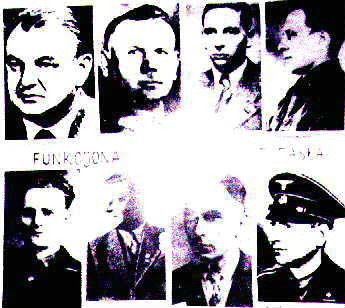
This photograph was taken in Yaslo by Max Findling. He returned
after the war to Yaslo, to the Prison where he was detained, the
Prison which is now a Museum. In the Museum, Max found this
picture on the wall; it was taken from a newspaper story of the
court trials of Nazi officers who were responsible for Jaslo and
the surrounding communities.. Some of those pictured here received
prison sentences.
Return to Table of Contents
. . . .
. . . .
. . . .
. . . .
The photograph on the left was taken in Landsberg, Germany
(a D.P. Camp in the American occupied sector) after the war, and
donated by Selig Eisenberg, a survivor. William Leibner,
Zvi Keren, Max Findling & Shimon Lang have identified the
following Zmigroders: (The Names have been updated as of
June, 2000!)
- Seated (Bottom line), left to right, Hanina
Eisenberg/Stein, Lea Bronfeld, Baruch Krebs, Berish Krebs,
Naftali Bronfeld and his wife, Jehshua Engel.
- Second line,left to right, Malka Eisenberg, Shimon
Lang, Lea Bronfeld's daughter, Jakob Leibner, Jechzkel/Chaskel
Bobker
- Third line, left to right, unknown,unknown, Reisel
Kornfeld with her baby (Shimon), Heniek [Henoch] Krebs [Brish
Krebs' son] standing, Izak Shaul/Szol Krisher standing
- Fourth Row, Standing: Jechezkel Krisher, Selig
Eisenberg and Chaim Kornfeld.
Return to Table of Contents
. . . .
. . . .
donated by Johanna Lehr 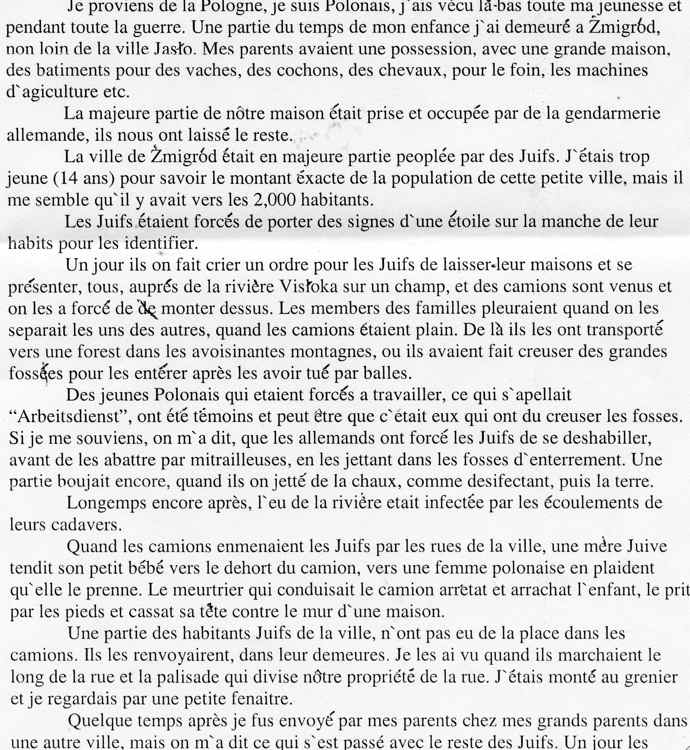

Here's a google translation...
I come from Poland, I'm Polish, I lived all my youth during the
war. Part of my childhood I spent in Zmigrod, not far from the
city of Jaslo. My parents owned land with a great house, buildings
for cows, pigs, horses, hay, agriculture machines, etc. The major
part of our house was taken and occupied by the German police,
they left us the rest.
The city of Zmigród was largely inhabited by Jewish people.
I was too young (14 years) to determine the exact amount of the
population of this town, but it seems to me that there was about
2,000 inhabitants. The Jews were forced to wear signs of a star on
the sleeve of their clothing to identify them.
One day they shouted an order for Jews to leave their homes and
present themselves, all near the river Visloka on a field, and
trucks came and they were forced to climb in. The family members
were crying when they were separated from each other, when the
trucks were in sight. From there they were transported to a forest
in the surrounding mountains, where they dug large pits to enter
after having been shot and killed. Young Poles who were forced to
work, what is called, "Arbeitsdienst", witnessed and may be it was
they who dug the graves. If I remember, I was told that the
Germans forced the Jews to undress before being shot by machine
guns, throwing them in the burial pits. Some Boujis again, when
you throw the lime, as desinfectant, then the earth.
Sometime after the river was infected by the ? of their bodies.
When comions Enmene Jews through the streets of the city, a Jewish
mother handed her baby to Dehorter truck, to a Polish woman to
pleaded that she take it. The murderer who was driving the truck
arrested him. wrenched away the child, took him by the feet and
crushed? his head against the wall of a house. Some of the Jewish
residents of the city, did not have room in the trucks. They
remained? in their homes. I saw them when they walked along the
street and the palisade that divides our property from the street.
I had climbed to the attic and watched by a small window.
Sometime after I was sent by my parents to the house of my
grandparents in another city, but they told me what happened with
the rest of the Jews. One day the Nazis (I do not know what group
or what was called the unit) have encircle the city? Kills the
rest of the Jewish population bullet shot on the streets and in
their homes. They closed the houses by pasting the letters to ban
anyone from entering, that the gendarmes had controll. These
policemen were not those who Enmene and kills, but there was one,
who killed the Polish Prisoner in the small prison town.
Another, I remember much later, had a brother who was hiding
among the Polish peasants, in a village nearby, because he was
wanted by the police because he did not go to battle in Russia.
I also saw the Nazis bring some Ziganas. The forced them to dig
their graves, they mo'ont? edge when I walked, then let me go. I
was told that they were killed. It was not far from the view of
the Jewish cemetery, not far from our house, near the road.
. . . .
Manny Getzler
Rochelle Getzler writes in January 2025:
The following information adds to the list of victims
murdered at Halbow.
I am the widow of Manny (Menachem) Getzler, who was the son of
Chaim Mordechai and Debora (Sternlicht) Getzler. Manny was born in
Berlin in December 1931, the youngest of three brothers.
Chaim Mordechai (Markus) Getzler, who was born in Zmigrod
(1892-1959), emigrated to Berlin in 1919, shortly after his
marriage, and incidentally following a pogrom in Zmigrod in 1918
when Chaim Mordechai was almost killed and his mother was badly
beaten.
His father and mother, Alter Salomon Getzler and Rivka (Rabi)
lived in Zmigrod, as did his younger brother Baruch and sister
Rachel (Rechl), and their families.
My husband’s family was expelled from Berlin and returned to
Zmigrod (via Zbaszyn and Cracow) in 1939. When war broke out in
September 1939, they fled to the east and were fortunate to
survive by deportation to Siberia. Subsequently, they emigrated to
Australia (in 1948, after spending time in Bergen Belsen DP Camp).
My husband, who died in January 2018, was a young child and did
not remember some details of the extended family in Zmigrod.
However, this summarises the details of his family and what he
heard of the death of his grandparents:
Rivka died in 1941, of natural causes. Postcards were sent to
Siberia by Alter and Baruch notifying Chaim Mordechai of her
death.
Alter Getzler was among the victims of Halbow (Manny thought that
Pinkas Wohlmut, who had been a hawker, had reported to his father
that he had observed the killing from a distance, and had observed
that Alter, an old frail man, was offered a seat before being
shot.).
We presumed that Alter’s son Baruch, his wife and two children
were among those killed at Halbow. Manny did not know the names of
Baruch’s family.
Alter’s daughter Rachel was a widow and had a son, Menyu. Manny
reported that her husband had been scholarly, and that the son was
bright. He did not know Rachel's married name. Again, we presumed
that she and her son were murdered at Halbow.
Manny’s memoir, Something out of Nothing: Recollections
(of) Manny Getzler, was published in December 2024.
Manny was a lively storyteller and was persuaded to record for his
family his memories of his life in Germany, Poland, Russia,
post-war Germany and Melbourne. Of particular interest to readers
of this site, the memoir includes a description of his
grandparents in Zmigrod (pp1-5); while a section in the Appendix
on Zmigrod (pp 65-79) contains his father's lament (written in
1947) in memory of the 1,250 Jews slaughtered at Halbow, as well
as photographs and selected documents - including the transfer of
the Getzler property in Zmigrod to Pinkas Wohlmut in 1951.
The memoir can be accessed electronically at:
https://nla.gov.au/nla.obj-3465837718/view
W. S. writes in May, 1998:
Jews and Poles lived together in Zmigród until the very end. They
couldn't cross the borders of Zmigród, which were marked by signs.
On the top of the hill of our road there was a sign. On that spot
a Jew was shot by a German gendarme.
Preceding to the tragedy on the Halbów, in May, 1942 all Jews
were ordered to assemble at the "Ball-place" ("ball" in the
meaning of having fun!), the sports field behind the bridge on the
road to Gorlice. Allegedly the tragedy was postponed to July 7,
1942, because of a large sum of ransom money.
One or two days before the grave had been dug out by youngsters
of the Baudienst. The crime was committed in the same way as our
officers were killed by the NKWD in Katyn: with a pistol shot in
the neck. Because the Gestapo-men were allegedly very drunk, many
people fell into the grave being only injured.
I rule out the use of machine-guns, because we would have heard
that. The only one, who was witness of this crime, was a resident
of Halbów, Lemek, who climbed up a pine-tree and sat there for the
whole day. He saw the tragedy. The Lemeks lived on the mountain
south to Zmigród, and were evacuated (resettled) to the Ukraine.
Neither Mr. Morawski nor Mr. Winiarski could have seen the crime.
Maybe they saw other tragedies. The grave was covered in with lime
and soil by Baudienst-youngsters.
Einhorn Mojzesz, son of Schape Hirsch and Szajndla, born
in Zmigród Nowy distr. Jaslo in 1908, testifies:
(Source: Document #3 (translated from Polish in April, 1998).
Rewritten by .... April 2, 1946 prot. D.Eichhornowa)
On July 7, 1942 the Germans assembled the Jews of Zmigród on the
sports field. They ordered Hersz Eisenberg, president of the
Judenrat, and the entire Rabbi family to stand apart.
A whole bunch of Gestapo-men, with Müller and Ganz at the head,
startedy pelting Eisenberg with beer-bottles, until they had
beaten him to death. Of the rest of the assembled people they
selected 1300 Jews. Together with the entire Rabbi family they
were loaded on vehicles and taken to the village of Halbów, 18 km
before Bardiów and 10 km behind Zmigród. There in the woods of
Halbów a few days before youngsters had dug out graves with a
length of about 50 m., the people were lined up over them, and
shot by machine-guns, destining one bullet for each of them, since
they said, that a Jew was not worth more than one bullet. In this
way the half-dead were falling into the grave. Afterwards the
Germans called men of the vicinity in to cover in the grave, and
the people of the vicinity told, that three days later the ground
was still moving.
I was told about it by my cousin Pinkas Wolmut, merchant, who
lived at that time in Zmigród and heard everything of
eye-witnesses. The death and killing of Eisenberg he saw himself.
Besides of him I was told about it by the regent of Zmigród, the
carpenter Morawski, now mayor, and by Winiarski, farmer and
citizen of Zmigród. To get to this mass-grave you have to drive to
Jaslo, and from there you go by cart via Zmigród to Halbów, to the
woods next to the dirt road that leads to Bardiów. The grave is
not fenced in, and cattle graze there. Zmigród has been destroyed
and there is not one single Jew left.
Cracau, January 17, 1946, Einhorn Moses,AZIH1764,(ZIH-Archives)
Return to Table of Contents
. . . .
. . . .
Osiek was just a small hamlet, 3 miles ESE of Nowy Zmigrod; its
coordinates are 49°38' / 21°29'.  Don't
confuse this southern Polish town which used to be in Galicia,
to the two Osieks in Northern Poland.
Don't
confuse this southern Polish town which used to be in Galicia,
to the two Osieks in Northern Poland.
This rural community is currently in the Jaslo district, but
was in the Krosno region from 1975-1998. Population in 2011 was
5400 people.
Resources
There's not much on the web to point you to, except the
following:
- JewishGen has a wonderful Communities Page
for Osiek Jasielski complete with links to
- town governments and history
- Yizkor Books
- other researchers (JewishGen FamilyFinder, JGFF),
- a list of nearby towns
- maps
You can find the page on JewishGen at
https://www.jewishgen.org/Communities/community.php?usbgn=-520233
or
click here.
- A Polish site which has some photographs...http://www.kirkuty.xip.pl/osieck.htm
- Jewish Records Indexing - Poland (JRI-P) has no
records directly from the town, but if you query Osiek you will
find a few records from other places for folks born in Osiek
(SCHOEFFLER, NORD, ROSENHAN) and a number from Zmigrod Nowy
(ALTHOLZ, SCHUMAN, HAZELBECK,WEINSTEIN, ERHARD, KRANZ, MEHR,
KELLER). Keep in mind there were 3 Osieks and you are searching
the one near Krosno/Jaslo/Zmigrod.
- Miriam Weiner's site, the RTRfoundation.org points to
existing records for the town which are filed under Ustrzyki
Dolne, at the Jewish Historical Institute in Warsaw, including
Polish Aliyah Passports granted 1929-1939.
- “Osiek Jasielski” - Encyclopedia of Jewish Communities in
Poland, Volume III (Poland). A Translation of “Osiek
Jasielski” chapter from Pinkas Hakehillot Polin, Published by
Yad Vashem, Published in Jerusalem, translated by Bill Leibner
and published on JewishGen;
Click here to read.
- Wikipedia: Gmina Osiek Jasielski is a rural gmina
(administrative district) in Jaslo County, Subcarpathian
Voivodeship, in south-eastern Poland. Its seat is the village of
Osiek Jasielski, which lies approximately 13 kilometres (8 mi)
south of Jaslo and 59 km (37 mi) south-west of the regional
capital Rzeszów. The gmina covers an area of 60.47 square
kilometres (23.3 sq mi), and as of 2006 its total population is
5,308.
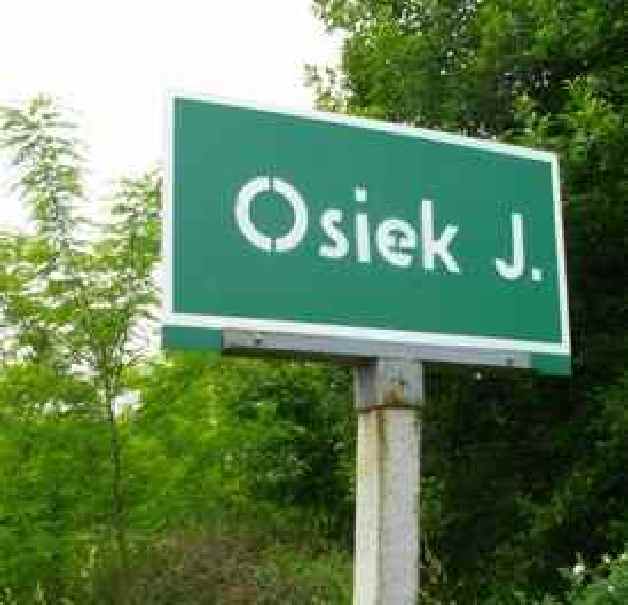 Rachelle wrote: "Dear Phyllis Basically in 2011 I went to Osiek
(Janielski) where my maternal grandmother came from. My grandmother,
Eidel TEITELBAUM, was born on 4th March 1890, her birth is
registered in Zmigrod, she was the daughter of Judah Yidell
TEITELBAUM, born in Osieck on 12.7. 1864, died in Palestine in 1942
and is buried on the Mount of Olives. His wife was Ester GOLDWENDER
who died on 22.5. 1908 aged 43.
Rachelle wrote: "Dear Phyllis Basically in 2011 I went to Osiek
(Janielski) where my maternal grandmother came from. My grandmother,
Eidel TEITELBAUM, was born on 4th March 1890, her birth is
registered in Zmigrod, she was the daughter of Judah Yidell
TEITELBAUM, born in Osieck on 12.7. 1864, died in Palestine in 1942
and is buried on the Mount of Olives. His wife was Ester GOLDWENDER
who died on 22.5. 1908 aged 43. 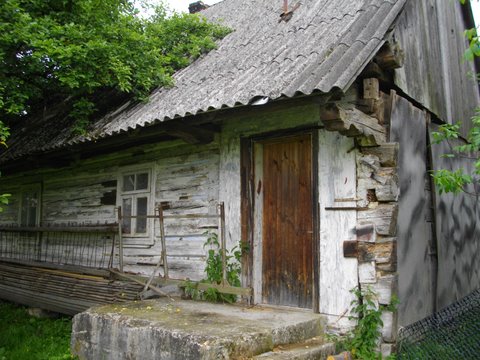
They had 9 children, all but the eldest had left Poland by the
time the war broke out. The eldest Chaim TEITELBAUM was born in
Osieck in 1886 and had 8 children. His father left him the family
business (a shop?) in Osieck when he moved to Frankfurt after the
death of his wife. It is assumed that Chaim and his family were
all shot in the massacre at the Halbrow forest in 1942 although I
have found a son, Solomon, listed as dying in Auschwitz in the Yad
Vashem database. So perhaps he was the eldest and had moved away
elsewhere by then.
Also according to my mother, after the war, a girl came to visit
my grandmother to explain she had been sheltered in the woods
during the war along with one of Chaim's daughters. But very near
the war's end, Chaim's daughter had decided she couldn't stand it
any more and she had to go and find out what had happened to her
fiancé. She was not seen or heard of again so presumably she was
caught or died of hunger and cold.
You are welcome to add anything you think suitable to your
webpages.
If you have any questions, please email me by clicking on my name,
Rachelle Smith 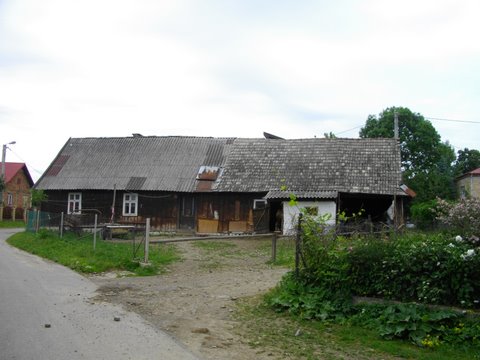
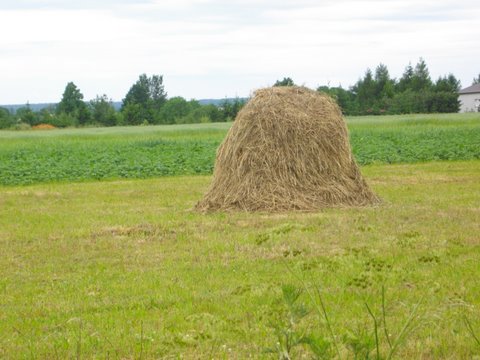
Cemetery Photos
Rachelle Smith 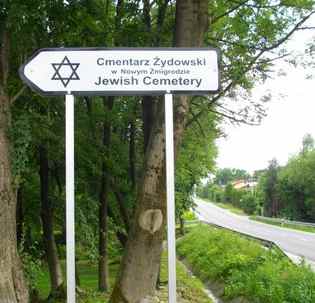

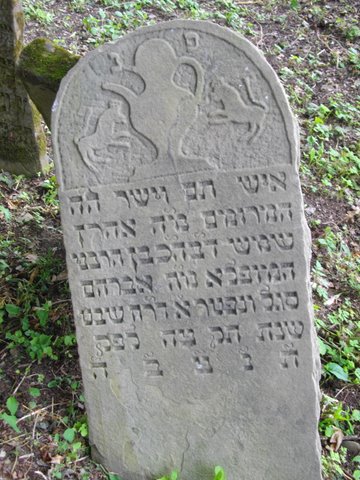
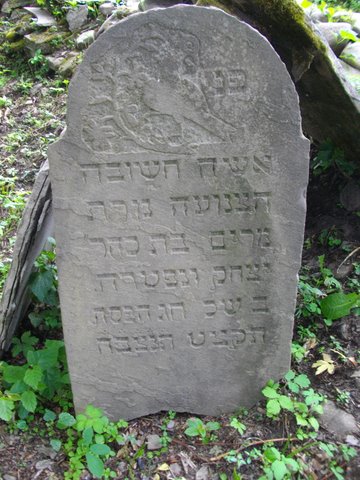
by William Leibner, Jerusalem 2004
The hamlet Osiek or Osiek Jasielski as it is called in official
documents is located south of Jaslo and north of Nowy Zmigrod,
Galicia, Poland. The Jews called the hamlet Oshik. There
is another village of Osiek but it is located near Baranow in
another region of Poland. This second Osiek also had a small
Jewish population. We are concerned with the first Osiek
Jasielski.
We do not know the precise historical beginning of Osiek
Jasielski but it is mentioned for the first time as a village
administrated under the Magdenburg law. It formed part of the
royal estate of the Polish Kings since 1365 and was granted the
status of city already in 1502.
In those days, it was an important place since it was
strategically located along a commercial route that led across the
Carpatian Mountains to Pressburg or present day Bratislawa and
Central Europe. A flourishing wine trade existed along this road
that provided Poland with Hungarian wines. The fortunes of the
Osiek declined with the building of modern roads and the
appearance of the railways practically demolished the economy of
the region. For it was much cheaper to ship wines or other
products via rail instead of horse drawn coaches. Osiek Jasielski
never recovered from the economic blow and continued to decline
economically, it even lost the municipal status. During the 19th
and 20th century, it became well known for its horse fairs.
We do not know when the first Jewish families settled in Osiek
but in the second half of the 19th century there was already a
Jewish population that consisted of 50 families.
The nearby Jewish community of Zmigrod provided the religious
needs of the early Jewish inhabitants including burial services.
Eventually, the Jewish population organized a small kehilla that
built a synagogue and a mikveh. The community even brought a
Rabbi, namely Aaron Halbershtam, the oldest son of the Zmigroder
Rabbi Sinai Halbershtam to administer the spiritual needs
of the hamlet. The Jews population consisted mainly of
peddlers, small businessman, artisans and horse dealers.
Jews began to leave Osiek prior to World War I in search of
economic opportunities. The exodus continued during the war since
the area was the scene of bitter fighting for control of the
mountain passes. Few of the families that left returned to Osiek.
The Jewish population continued to decline and sought better
economic opportunities elsewhere. The Jewish population was
basically very orthodox although there was some Zionist
activities, especially amongst the Jewish youth. The local
Christian population was very anti-Semitic and made life difficult
for the Jews. Jewish children were harassed in the local public
school, their peyot or earlocks were clipped or they were forced
to kneel not far from a cross. Osiek accepted with joy the ban on
ritual slaughter that closed the only kosher butcher shop in the
hamlet. Thus, the Jews had to bring kosher meat from other places.
The Germans occupied the hamlet and immediately issued
anti-Jewish orders, namely limiting Jewish mobility to the village
itself. Jews were then forced to wear armbands. Their economic
situation worsened from day to day. A branch of the JSS (Jewish
Self-Help) was activated that distributed warm meals to the needy
and tended to the sick. The German economic measures against the
Jews hardened as the war progressed. The Jewish families were
being pauperized while the German demands kept increasing. More
Jewish forced laborers, more financial impositions and more edicts
against the Jews. Then suddenly, Jews were being forced to leave
Osiek Jasielski for Zmigrod, the nearby Jewish community. The
process repeated itself several times until all the Jews of
Osiek Jasielski and surrounding villages were driven to Zmigrod
on July 7th 1942. Here they shared the fate of the Jews of
Zmigrod. Namely on July 7th 1942, all the Jews were ordered to
appear at Bal’s place. Here the selection occurred. The young and
able-bodied people were ordered to the side, the rest of the
Jewish population was driven to a place called Halbow
where they were shot and fell into prepared pits. The pits were
then covered with lime. The able bodied Jews were driven back to
Zmigrod. Shortly thereafter, they were assembled and about 150
people were selected and sent to the death camp of Plaszow in
Krakow. Another group was sent to the Zaslaw labor camp. Some
Jews escaped to the surrounding forests or hid in prepared
hiding places. The remaining Jews were then sent to Belzec death
camp. Thus ended Jewish life in Osiek Jasielski.
Sources:
Pinkas Hakehilot
Written testimony in Yiddish of Samuel Rosenhan at Yad Vashem,
a native of Osiek Jasielski
Interviews with survivors from Osiek and Nowy Zmigrod
Return to Table of Contents
. . . .
| Axselrad |
Mathilde |
7/28/07 |
Nee Berger; resident of Wurzburg; deported from Mechelin
1942 to Auschwitz |
| Aumann |
Selig |
3/10/83 |
Resident of Dortmund; expelled 10/28/38 to Bentschen |
| Beck |
Reisel |
5/15/98 |
Deported from Frankfort am main 11/11/41 to minsk ghetto
|
| Berger |
Heinrich |
8/8/07 |
Resident of Nurnberg |
| Berger |
Jenta Janette |
10/22/89 |
Nee gartner; deported from Poland to belzec |
| Berger |
Joseph |
8/30/87 |
Resident of Munchen; died Belzec |
| Bergmann |
Chaja sara |
8/3/90 |
Nee Zanger; Resident of Berlin; deported from mechelin
1942 toAuschwitz |
| Birnbach |
Regina |
8/10/01 |
Resident of Dortmund; expelled 10/28/38 to Bentschen;
officially declared dead |
| birnbach |
Szulem salomon |
1/15/97 |
expelled 10/28/38 to Bentschen; |
| Blechner |
Basia |
8/10/08 |
Expelled 10/28 to Poland |
|
Lea |
1/18/74 |
Nee findling; Expelled 10/28 to Poland |
| Bleicher |
Laja |
1/18/74 |
Resident of Chemnitz; imprisioned until summer 1939
Bentschen |
| Bobker |
Eleiser |
1/7/99 |
Resident of Frankfort am main, deported july 1944
Auschwitz |
| Citronenbaum |
Chaim |
7/6/77 |
expelled 10/28/38 to Bentschen; deported april 1940 to
Tarnow, died 1942 Tarnow ghetto |
| Drattler |
Berta |
2/15/81 |
Deported from Nurnberg to ghetto Riga |
| Ehrenfreund |
Estera |
2/14/85 |
Resident of hannover; expelled 10/28/38 to Bentschen |
| Erreich |
Elja |
1888 |
Nee Krill; deported from Leipzig sept 1942 to
Theresienstadt, died 1/43 |
| Erreich |
Herman Hershel |
10/26/95 |
Resident of Karlsruth, deported from hub bel buhl june
1940 to grafeneck, killing facility |
| Erreich |
Moses |
1/18/72 |
Imprisioned sachsenhosen 1939, Dachau, Buchenwald |
| Fiebach |
Joseph |
5/20/00 |
Resident of leipsig, expelled 1938 to Poland |
| Findling |
Mechel |
8/12/09 |
Resident of Chemnitz, expelled 10/28/38 to Poland |
| Findling |
Rachella |
1/12/91 |
Resident of hannover; expelled 10/28/38 to Bentschen |
| Findling |
Rachella |
4/12/11 |
Resident of chemnitz; expelled to poland; deported from
weimar-leipsig 1942 to belzyce, ghetto |
| Findling |
Samuel Jacob |
3/14/62 |
Resident of Leipsig; expelled 1938 to poland |
| Gross |
Moses |
7/27/84 |
Emigration Netherlands 1939; deported from westerbrook
1942 to Auschwitz |
| Gross |
Naftali |
10/10/93 |
Imprisioned sachsenhosen 1939, died 1939 |
| Grosshaus |
Sabina |
5/14/91 |
Resident of Frankfort am main, deported 1941 kowno, died
1941 |
| Gruen |
frimeta |
5/14/91 |
Nee Hollander; Expelled 11/28 to Poland |
| Hirschberg |
Leo |
7/3/98 |
resident of Wilhelmshaven and Rüstringen;Expulsion:11th
June 1939 to Poland, died Auschwitz |
| Hormann |
Bella |
12/25/12 |
Resident of frankfort am main; deported 1942 to sobibor,
died sobibor |
| Hormann |
Joseph |
11/20/04 |
Resident of frankfort am main;; imprisioned sachsenhausen
1940, Buchenwald 1941; died Buchenwald |
| Hormann |
Necha |
10/14/74 |
Nee Cohn; Resident of frankfort am main; deported 1942
theresienstadt, 1942 Treblinka |
| Horschkowitz |
Salomon |
8/16/54 |
Resident of Berlin; expelled 1938/9 to Poland |
| Indig |
Lieba |
3/20/71 |
Nee Scherer; resident of Frankfort am main; deported 1942
theresienstadt, 1943 Auschwitz |
| Just |
Henoch/Hirsch |
10/5/79 |
Deported from berlin feb 1943 to Auschwitz |
| Kratzer |
szprinca |
10/10/90 |
Resident of Dortmund, expelled 10/28/38 to Bentschen |
| Kampler |
Hinda |
5/1/84 |
Deported to sachsenhausen |
| Kessler |
Israel |
1/8/88 |
Deported from berlin feb 1943 to Auschwitz |
| Krieser |
Isak leiser |
10/24/90 |
Resident of berlin; emigration dec 1938 to belgien;
deported from mechelin august 1942 to Auschwitz |
| Krzeszower |
Laja |
3/16/95 |
Resident of koln; expelled 8/1938 to Bentschen |
| Lerner |
Gittel |
11/25/19 |
Resident of berlin; deported from berlin 1944 to
Auschwitz |
| Lerner |
Ita |
4/10/86 |
Nee Findling; deported from berlin March 1943 Auschwitz |
| Malz |
Rosa |
4/5/89 |
Resident of fulda; deported from Frankfort am main august
1942 to theresienstadt, ghetto; died 1944 |
| Margules |
Jakob |
9/15/96 |
Resident of berlin; Explulsion 1938 to Bentschen |
| Melamed |
Rachel |
1/21/00 |
nee bierowska; Explulsion 1938 to Bentschen |
| Mond |
Rosa |
12/17/91 |
Nee gross; resident of koln, emigration: Belgian;
deported from mechelin august 1942 to Auschwitz |
| Neumann |
Breindel |
2/15/80 |
Resident of Breslau; deportation 1942 to Izbica, ghetto |
| Reinhold |
Heinrich |
11/11/84 |
Resident of Heidelberg; Explulsion 1938 to Bentschen;
declared dead |
| Rettig |
Chawa |
8/10/68 |
Nee Wein; Expelled 5/39 to Poland |
| Rosen |
Erna regina |
3/21/07 |
Resident of Frankfort am main; deported from mechelin
(Malines) to Auschwitz |
| Rosner |
Sabina |
2/22/87 |
Nee Zanger; deportation unknown |
| Rottenberg |
Rosa Rachel |
1893 |
Resident of berlin (prenzlauer berg); Explulsion 1938 to
Bentschen |
| Scherl |
Necha netty |
10/11/95 |
Nee Zanger; deported from Berlin 1941 to Ria, died Riga
Rumbula |
| Schonberg |
Dressel |
5/5/66 |
Nee Kolber; resident of Berlin; deported to
Theresiensdadt ghetto, deported to Treblinka 1942 |
| Sekler |
Berta |
1/15/89 |
Nee Lang; deported from mechelin (Malines) 1942 to
Auschwitz |
| Semler |
Chawa chana |
4/8/76 |
|
| Sindel |
julius |
|
Explulsion 1938 to Poland |
| Spalter |
Pepi pessia |
1/5/89 |
Nee Rosenthal; Resident of Hannover; Explulsion 1938 to
Bentschen |
| Unger |
Rosa reisel |
12/22/86 |
Nee Fenig; Resident of berlin; deported Auschwitz |
| Wagschal |
abraham |
10/21/82 |
Explulsion 1938 to Bentschen |
| Wajnstock |
Freida |
9/15/00 |
Nee Klein; resident of saarbrucken; emigration
tschechoswakei (CSR); deportation from prag 1942
therewienstadt ghetto;baranowitschi ghetto |
| Wasserman |
Niche |
10/10/01 |
Nee Gross; resident of hamburg; Explulsion 1938 to
Bentschen |
| West |
Elka |
4/15/91 |
|
| Wilkenfeld |
Regina |
3/15/02 |
Nee karger; emigration 1939 poland; deportation
Auschwitz, died 1942 |
| Zimet |
Minna mindel |
4/28/06 |
Nee Lang; resident of Berlin, emigration 1939 poland,
died zmigrod 1942 |
| Zimet |
Wolf david |
11/12/91 |
Resident of Berlin (Mitte); Emigration Niederlande;
deportation from westerbork jan 1944 to theresienstadt,
ghetto; 1944 to Auschwitz, officially declared dead |
Return to Table of Contents
. . . .
 monuments. These monuments have inscribed the
date and the year of the execution in three languages: Hebrew,
Polish and English. This mass grave is covered with a cement
block measuring 30 feet long by 12 feet wide. There is a metal
fence surrounding this entire site. In addition there is a road
sign about two hundred and fifty meters from the gravesite. This
sign informs visitors of the mass grave located within the
forest ahead. The monuments and sign were erected with donations
from surviving members as well as their families and friends.
monuments. These monuments have inscribed the
date and the year of the execution in three languages: Hebrew,
Polish and English. This mass grave is covered with a cement
block measuring 30 feet long by 12 feet wide. There is a metal
fence surrounding this entire site. In addition there is a road
sign about two hundred and fifty meters from the gravesite. This
sign informs visitors of the mass grave located within the
forest ahead. The monuments and sign were erected with donations
from surviving members as well as their families and friends.  This Shtetlinks page was
created by Phyllis Kramer. Updated January 2019. Copyright © 2000.
Since August 2001, you are visitor#:
This Shtetlinks page was
created by Phyllis Kramer. Updated January 2019. Copyright © 2000.
Since August 2001, you are visitor#:  This forest Warzyce
includes thirty two mass graves where over five thousand people
were executed. On the unmarked grave of our loved ones we placed
a bronze plaque, brought from the United States, prepared with
the names of those buried.
This forest Warzyce
includes thirty two mass graves where over five thousand people
were executed. On the unmarked grave of our loved ones we placed
a bronze plaque, brought from the United States, prepared with
the names of those buried. 
 and for this we are very grateful. Thankyou.
and for this we are very grateful. Thankyou.  establishment of the monuments in Halbow, Poland, when he
returned to Jaslo. Among the victims of the Nazi massacre was
his aunt Malka Siegfried-Lerman, her husband and her children
from Oscik. The only member to survive was Moisha Lerman.
establishment of the monuments in Halbow, Poland, when he
returned to Jaslo. Among the victims of the Nazi massacre was
his aunt Malka Siegfried-Lerman, her husband and her children
from Oscik. The only member to survive was Moisha Lerman. 



 Don't
confuse this southern Polish town which used to be in Galicia,
to the two Osieks in Northern Poland.
Don't
confuse this southern Polish town which used to be in Galicia,
to the two Osieks in Northern Poland. 






